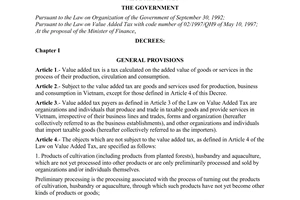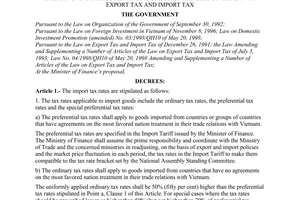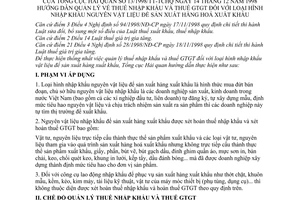Nội dung toàn văn Circular No. 13/1998/TT-TCHQ of December 14, 1998 guiding the management of import tax and value added tax on raw materials and materials imported for export goods production
|
THE GENERAL DEPARTMENT OF CUSTOMS |
SOCIALIST
REPUBLIC OF VIET NAM |
|
No. 13/1998/TT-TCHQ |
Hanoi, December 14, 1998 |
CIRCULAR
GUIDING THE MANAGEMENT OF IMPORT TAX AND VALUE ADDED TAX ON RAW MATERIALS AND MATERIALS IMPORTED FOR EXPORT GOODS PRODUCTION
Pursuant
to Point 3, Article 4 of Decree No.94/1998/ND-CP of November 17, 1998 detailing
the implementation of the Law Amending and Supplementing a Number of Articles
of the Law on Export and Import Tax;
Pursuant to Point 2, Article 14 of the Law on Value Added Tax;
Pursuant to Point 21, Article 4 of Decree No.28/1998/ND-CP of November 18, 1998
detailing the implementation of the Law on Value Added Tax;
For the uniform management of import tax and value added tax on raw materials
and materials imported for export goods production, the General Department of
Customs hereby provides following implementation on guidance:
I. SCOPE OF REGULATION
1. The import of raw materials and materials for export goods production is conducted in the form of definitive purchase and sale with the owners of imported raw materials and materials being enterprises engaged in production and/or business activities inside Vietnam (including investment enterprises and joint ventures) that register and set models and norms for consumption of raw materials and materials by themselves and take responsibility to turn out products shall seek markets for export of such products by themselves.
2. The raw materials and materials imported for export goods production, which shall be considered for import tax or value added tax reimbursement, include:
Materials and raw materials which directly constitute the substantial contents of export products and those which are used in the process of producing export goods but do not constitute the substantial contents of export products, such as: paper, chalk, painting brushes, marker pens, clothes� pins, printing inks and paints, glue brushes, glue spreading brushes, silk-screen printing frames, bleached crepe, varnishes, etc., of which the enterprises have set materials consumption norms for their product units.
3. Working tools imported to serve the export goods production, such as: chopping boards, molds and models, pliers, scissors, serving machine needles, technical documents and components of machines and equipment (spare parts, tools...) shall not be considered for import tax and value added tax reimbursement according to the above stipulations.
II. THE IMPORT TAX AND VALUE ADDED TAX MANAGEMENT REGIME
1. Raw materials and materials imported for export goods production are subject to import tax and value added tax and eligible for reimbursement of such taxes corresponding to the percentage of export products based on the raw materials and materials consumption norms.
2. The import tax and value added tax payment grace period for raw materials and materials imported for export goods production is 9 months (275 days) from the date the tax payers receive the official tax notices from the customs authorities on the payable tax amounts.
a) During the 275-day grace period, enterprises which have actually exported their products shall not have to pay import tax and value added tax on the imported raw materials and materials volume corresponding to the actually exported product volume, based on the raw materials and materials consumption norms.
b) Beyond the 275-day grace period, if enterprises still fail to actually export their products or to fully export the product volume that must be exported corresponding to the imported materials, they shall have to pay import tax and value added tax for raw materials and materials volume corresponding to the volume of products not yet exported. Such tax amounts shall be remitted into the temporary collection account which is in essence, the suspense account in order to monitor and facilitate the tax reimbursement. Once they actually export their products, the enterprises shall have their already paid import tax and value added tax reimbursed. If past 275-day time limit, the enterprises still fail to pay import tax and value added tax for the corresponding raw materials volume, they shall, as from the 276th day on, be subject to a fine equal to 0.1 per cent (one thousandth) of the payable tax amount for each day of delayed payment until they actually export the volume of products produced from the imported raw materials and materials.
c) For the volume of raw materials and materials allowed to be domestically sold, the enterprises shall have to pay import tax and value added tax to the State budget as prescribed.
3. The procedures and competence to consider the reimbursement or non-collection of import tax and/or value added tax.
a) A dossier applying for reimbursement (non-collection) of import tax and/or value added tax shall comprise:
- An official written request for the reimbursement (non-collection) of import tax and/or value added tax, already paid by the concerned enterprise, which clearly states the export goods quantity, imported raw materials and materials consumption level, import tax and/or value added tax amounts already paid and the requested for reimbursement;
- The goods export contract signed with foreign countries (clearly stating the quantity, specifications, quality, categories ... of export goods) and the contract for import of raw materials and materials for the production of export goods;
- The import customs declaration of raw materials and materials which has already been liquidated by the customs authority;
- The export customs declaration with certification of the actual export volume by border-gate customs authority;
- The tax payment receipt (tax notice);
- The contract for entrusted export and/or import (in case of entrusted export and import).
The norms for raw materials and materials consumption in the production of export goods shall be set by the enterprises, and the enterprises’ directors shall take responsibility for the legal grounds and the accuracy of the norms registered with the customs authority (where the procedures for export and import of products shall be carried out later). The registration of the norms with customs authority shall be made before the import procedures are carried out. In cases where the registered norms are not compatible with the actual raw materials and materials consumption level, the enterprise shall have to promptly send a report thereon to the customs authority where the norms have been registered to serve as basis for the liquidation and tax reimbursement for the registered goods lot.
b) Tax amount collected by the customs authority shall be deposited into a separate account of the provincial/municipal customs department at the State treasury. When subjects eligible for tax reimbursement submit their dossiers requesting the tax reimbursement, the provincial/municipal customs department shall base itself on the dossiers to verify, consider and sign decisions on tax reimbursement or non-collection, and then effect such tax reimbursement to eligible subjects from the above-said temporary collection account at the State treasury.
III. ORGANIZATION OF IMPLEMENTATION
1. The customs procedures for the import of raw materials and materials for the production of export goods (in form of definitive sale and purchase) shall be carried out as for export and import goods lots.
Enterprises that import raw materials and materials for the production of export goods shall have to declare for tax calculation and register for carrying out of the procedures according to the current regulations.
The customs authority shall carry out the procedures for checking and determining the payable import tax and value added tax amounts, issue notices within a time limit of 275 days and monitor, manage and liquidate each export or import goods lot according to regulations.
2. The procedures for supervising and managing the import of raw materials and materials for the production of export goods shall comply with Regulation No.126/TCHQ/GSQL of April 8, 1995 of the General Department of Customs (parts concerning the supervision and management of the import of raw materials and materials for the production of export goods) and the current regulations of the Ministry of Finance, the Ministry of Trade and the General Department of Customs.
3. With a tax payment grace period of 275 days prescribed for the import of raw materials and materials for the production of export goods, and in order to make the management and supervision work strict and effective, thus preventing cases of taking advantage of the 275-day tax payment grace period to import raw materials and materials not for the production of export goods, or use only a part of the imported materials volume in the export goods production. The sale of the remaining volume of imported raw materials and materials on the domestic market, must be permitted by the Ministry of Trade (if the imported raw materials and materials are regulated by quotas). In this case, the enterprises shall have to declare for tax payment with the customs authority in the locality, where they have already registered their import declarations, within two (02) days after the change in the use purpose of imported raw materials and materials. Enterprises that sell imported raw materials and materials on the domestic market shall, besides having to pay import tax and value added tax, be subject to a fine for delayed payment of such taxes and be handled for their violations of tax legislation.
4. This Circular takes effect from January 1st, 1999.
All previous guiding documents which are contrary to this Circular are now annulled.
The provincial/municipal customs departments shall organize the thorough study and implementation of this Circular and report problems arising in the implementation course to the General Department of Customs for its timely direction and guidance.
|
General Director of
Customs |



